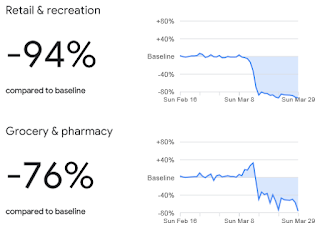Some of results offer an insight to how nations are different.
In most countries, the actions taken have significantly reduced shopping, mass transit use and going to restaurants and cafes.
For instance, UK:
Spain:
Italy:
But Sweden is quite different - much smaller decrease in restaurant-going, shopping, and going to ski resorts:
Finland has reduced these activities more than the Western neighbour:
But the actual differences are in outdoor life. UK, and especially Spain and Italy, have seen drastic reduction in access to places like national parks, public beaches, marinas, dog parks:
But Sweden has again it quite different:
Finland is not completely unique, though. There are some states in the U.S. that are similar, e.g. West Virginia. But the most extreme I found is the state of Montana, which has seen reduction in retail and some in grocery, but access to parks has more than doubled.
It is likely that Finland's smaller reduction of mobility in shopping and recreation compared to Italy or Spain is because our baseline is significantly lower: population density is lower, and people here have always kept a longer physical distance to other people. We don't go as often to restaurants and cafes, and shops are less crowded.
But the park figure is interesting. It clearly shows that we feel that there is space there, and it is safe to go out in the nature.











Ei kommentteja:
Lähetä kommentti